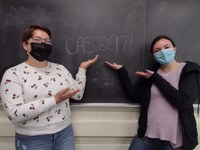Reflections on Shootings in Buffalo and Dallas
The mission statement of the Department of Communication Arts & Sciences opens with this sentence: “CAS is committed to the study, teaching, and practice of human communication for the betterment of Pennsylvania, the nation, and the world.” As we close the books on another academic year, can we say we are succeeding?
What happened in Buffalo was a methodical act to kill Black people going about the normal business of their lives. In the past month, a shooter has targeted a number of Asian-run businesses in Dallas. The attacks resemble the 2021 rampage in Atlanta that victimized Asian women solely for being Asian women. In 2019, a shooter targeted Hispanic shoppers at a Walmart in El Paso, killing 23 people. In 2018, eleven people were shot dead while attending services at a synagogue in Pittsburgh. These are certainly not the only mass shootings in the past five years. They are not even the deadliest. They are just a sample of the ones motivated by the violence of racism.
In past years, the department has sponsored events to encourage “Talking Together about Guns,” in hopes that deliberative discussion of the values underlying pro- and anti-gun positions could break down that simple binary and encourage useful dialogue. In small groups, it did. We also held a “Voices of Democracy” event to resurrect the courage of people who spoke wisdom in the face of fear and hatred. Our faculty and graduate students have written dissertations, articles, and books on relationships among communication, violence, and civic health. We also endeavor every semester to encourage our students to ask difficult questions and to listen carefully for responses that can counteract the polarized political and social environment in which we find ourselves. Simple truths, while so often appealing, are inadequate in complex times. Instead, we ask our students, in dialogue across differences and with a commitment to the principles of ethical communication, to consider complex truths.
Meanwhile, however, people continue to be killed. Our community might wonder: “Could what happened in Buffalo, in Dallas, in Atlanta, in El Paso, in Pittsburgh – in so many cities and towns across the United States – happen here?” The answer is yes. The answer is also that this isn’t the most important question. That racially motivated mass shootings happen anywhere within the reach of our humanity is enough for them to touch us indelibly.
We have seen in the past two years how much can be mobilized in the effort to contain a sometimes-lethal virus. Can we not mobilize to contain the often-lethal virus that is racist violence? Success might be the sum of small efforts, and the CAS Department will continue on with our mission. We will also ask ourselves how to do more.
